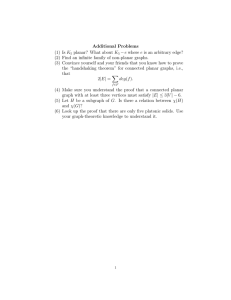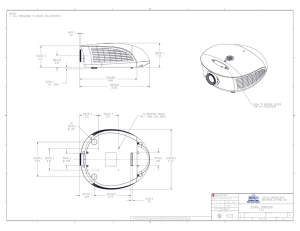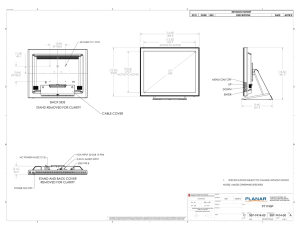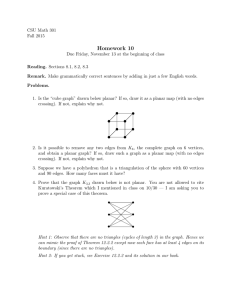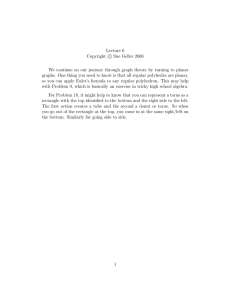Electrical networks and Lie theory, Boulder 2013
advertisement
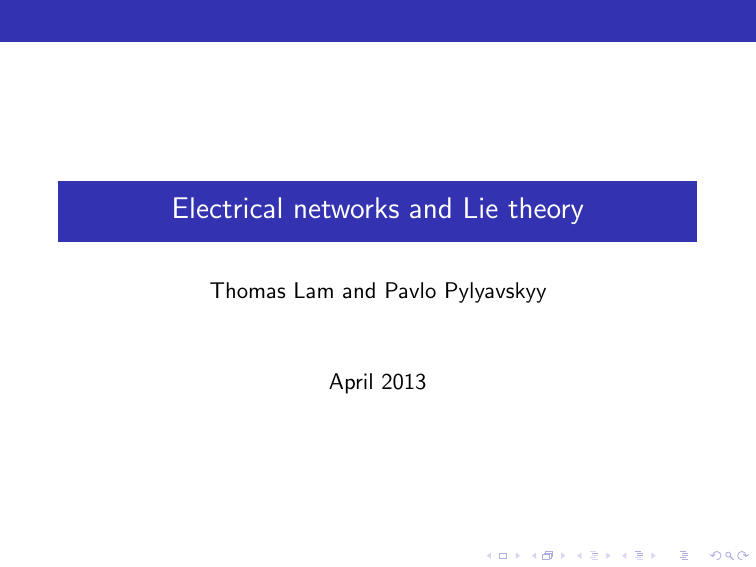
Electrical networks and Lie theory
Thomas Lam and Pavlo Pylyavskyy
April 2013
Electrical networks
An electrical network consisting only of resistors can be modeled
by an undirected weighted graph Γ.
1
0.1
4
2
1
1
1.3
0.5
Edge weight = conductance = 1/resistance
2
Response matrices
The electrical properties are described by the response matrix
L(N) : R#boundary vertices → R#boundary vertices
voltage vector 7−→ current vector
which gives the current that flows through the boundary vertices
when specified voltages are applied.
Axioms of electricity
The matrix L(N) can be computed using only two axioms.
Kirchhoff’s Law
The sum of currents flowing into an interior vertex is equal to 0.
Axioms of electricity
The matrix L(N) can be computed using only two axioms.
Kirchhoff’s Law
The sum of currents flowing into an interior vertex is equal to 0.
Ohm’s Law
For each resistor we have
(V1 − V2 ) = I × R
where
I = current flowing throught the resistor
V1 , V2 = voltages at two ends of resistor
R = resistance of the resistor
To compute L(N), we give variables to each edge (current through
that edge) and each vertex (voltage at that vertex). Then solve a
large system of linear equations.
Some basic problems
Inverse problem
To what extent can we recover N from L(N)?
Some basic problems
Inverse problem
To what extent can we recover N from L(N)?
Detection problem
Given a matrix M, how can we tell if M = L(N) for some N?
Some basic problems
Inverse problem
To what extent can we recover N from L(N)?
Detection problem
Given a matrix M, how can we tell if M = L(N) for some N?
Equivalence problem
When do two networks N and N ′ satisfy L(N) = L(N ′ )?
Electrical relations
Series-parallel transformations:
a
b
a+b
a
b
ab/(a + b)
Electrical relations
Series-parallel transformations:
a
a+b
a
b
ab/(a + b)
b
Y − ∆, or star-triangle transformation:
C
a
b
B
A
c
ac
ab
bc
, B=
, C=
,
a+b+c
a+b+c
a+b+c
AB + AC + BC
AB + AC + BC
AB + AC + BC
a=
, b=
, c=
.
A
B
C
A=
Planar electrical networks
Theorem (Curtis-Ingerman-Morrow and Colin de
Verdière-Gitler-Vertigan)
Consider planar electrical networks with n boundary vertices.
1
Any two planar electrical networks N, N ′ such that
L(N) = L(N ′ ) are related by local electrical equivalences.
2
The space Pn of response matrices consists of symmetric
n × n matrices, with row sums equal to 0, and such that
certain “circular minors” are nonnegative.
3
We have
#edges in Gi
Pn = ⊔Gi R>0
where {Gi } is a finite collection of unlabeled graphs, and each
cell is parametrized by giving arbitrary positive weights to the
edges.
Planar electrical networks
Theorem (Curtis-Ingerman-Morrow and Colin de
Verdière-Gitler-Vertigan)
Consider planar electrical networks with n boundary vertices.
1
Any two planar electrical networks N, N ′ such that
L(N) = L(N ′ ) are related by local electrical equivalences.
2
The space Pn of response matrices consists of symmetric
n × n matrices, with row sums equal to 0, and such that
certain “circular minors” are nonnegative.
3
We have
#edges in Gi
Pn = ⊔Gi R>0
where {Gi } is a finite collection of unlabeled graphs, and each
cell is parametrized by giving arbitrary positive weights to the
edges.
Recently, Kenyon-Wilson developed a theory connecting electrical
networks to the enumeration of “groves” in graphs.
Operations on planar electrical networks
2
1
1
0.1
4
2
N=
1.3
0.5
4
1
1
2
3
Operations on planar electrical networks
2
1
1
1
a
0.1
2
u1 (a).N =
1.3
0.5
4
4
1
1
2
3
Operations on planar electrical networks
2
a
1
0.1
1
4
2
u2 (a).N =
1.3
0.5
4
1
1
2
3
Relations
The operations ui (a) satisfy the relations:
ui (a)ui (b) = ui (a + b)
due to series-parallel equivalences, and
Relations
The operations ui (a) satisfy the relations:
ui (a)ui (b) = ui (a + b)
due to series-parallel equivalences, and
ui (a)uj (b)ui (c) = uj (
bc
ab
)ui (a + c + abc)uj (
)
a + c + abc
a + c + abc
due to Y − ∆ equivalence.
Lusztig’s braid relation in total positivity
1 a 0
x1 (a) = 0 1 0
0 0 1
1 0 0
x2 (a) = 0 1 a
0 0 1
satisfies
x1 (a)x2 (b)x1 (c) = x2 (
ab
bc
)x1 (a + c)x2 (
)
a+c
a+c
Lusztig’s braid relation in total positivity
1 a 0
x1 (a) = 0 1 0
0 0 1
1 0 0
x2 (a) = 0 1 a
0 0 1
satisfies
x1 (a)x2 (b)x1 (c) = x2 (
ab
bc
)x1 (a + c)x2 (
)
a+c
a+c
Very similar to
ui (a)uj (b)ui (c) = uj (
bc
ab
)ui (a + c + abc)uj (
)
a + c + abc
a + c + abc
Electrical Lie algebras el2n
generators: e1 , e2 , . . . , e2n
relations:
[ei , ej ] = 0 if |i − j| ≥ 2
[ei , [ei , ei ±1 ]] = −2ei
Electrical Lie algebras el2n
generators: e1 , e2 , . . . , e2n
relations:
[ei , ej ] = 0 if |i − j| ≥ 2
[ei , [ei , ei ±1 ]] = −2ei
Theorem (L.-Pylyavskyy)
1
We have el2n = sp2n and so dim(el2n ) = dim(n+ (sl2n+1 )).
2
In the simply-connected Lie group EL2n (R) the elements
ui (t) = exp(t ei )
satisfy all the relations from before.
Electrical Lie algebras el2n
generators: e1 , e2 , . . . , e2n
relations:
[ei , ej ] = 0 if |i − j| ≥ 2
[ei , [ei , ei ±1 ]] = −2ei
Theorem (L.-Pylyavskyy)
1
We have el2n = sp2n and so dim(el2n ) = dim(n+ (sl2n+1 )).
2
In the simply-connected Lie group EL2n (R) the elements
ui (t) = exp(t ei )
satisfy all the relations from before.
There appear to electrical Lie algebras associated to any Dynkin
diagram of a finite-dimensional simple Lie algebra. Yi Su has
described the type C analogue and associated action on
mirror-symmetric planar electrical networks.
